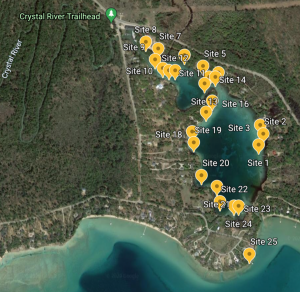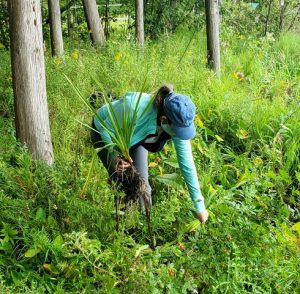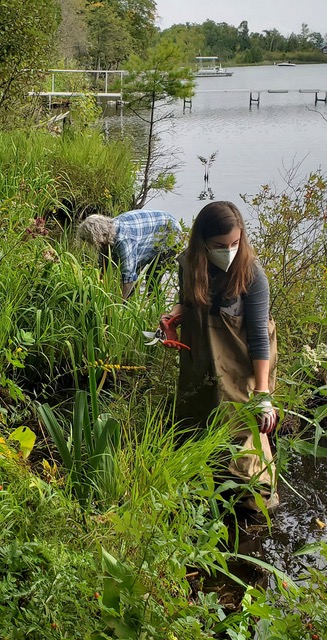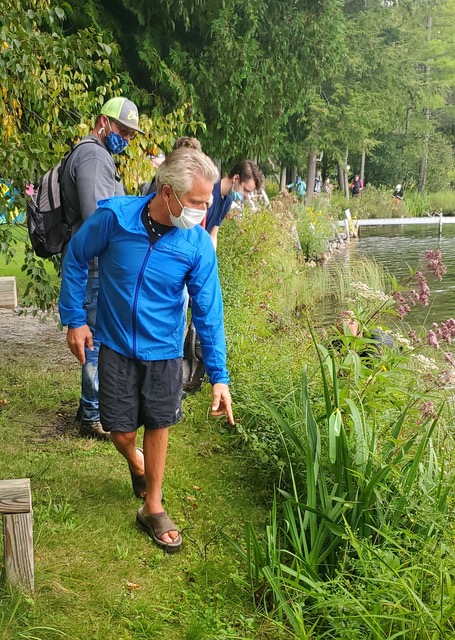
At left, yellow iris sites on Fisher Lake.
The invasive species yellow iris has spread in the watershed over the past several seasons and the GLA is asking riparians for their help in eradicating the plants. Property owners have been notified and are part of the solution to combat the spread. A group of nine NMC Freshwater Studies Program students are currently working with our GLA interns, assisting with identification, mapping and removal.
The work is focusing on the Fisher Lakes, but plants also can be found on the north and east shores of Big Glen and along the Crystal River. The removal project this season is expected to continue through the first week of October.
 Background:
Background:
Native to Europe, Northern Asia, the Middle East and northern Africa, the yellow iris (Iris pseudacorus) most likely made it’s way to our shores as an ornamental plant. Many landscapers, pond designers and home gardeners choose to include it in their designs for it’s beautiful yellow flowers in bloom from mid June to mid July. It is lovely, in bloom, but problems arise when the seed pods mature, arch over the water, split open and disperse. It can travel far and wide on the waters of our lake, washing into crevices, lodging against berms and taking root. Over time it can create a dense mass, choking out the diversity of native plants that keeps our shores looking like northern Michigan and that keep our local ecosystem healthy.

Discovery:
Observed increasing over last several years by our watershed scientist Rob Karner and invasive plant specialist Laurel Voran. Laurel has been aware of this plant’s agressive nature from her work in the horticultural field and from the experiences of others in our region and nationwide. One person who has been involved with controlling this plant around Portage Lake described his experience like a game of “whack-a-mole” : “At first there were just a few, and then we found it popping up here, there and everywhere!”
Response:
This year we have taken efforts to carefully identify and document where yellow iris has taken root. We have done surveys by boat, by foot and by drone to assist in documenting as many current infestation sites as possible using mapping software.
We have removed the seed pods of any plants that flowered this summer to prevent further spread via water currents. (the seedpod stems arch down and can release into the water – spreading far and wide.)
Small infestations have been removed by digging. We are in the process of contacting affected landowners and determining best methods to destroy larger populations.

What you can do:
- 1: Contact us immediately if you know you have yellow iris and have not already heard from us. Remove any existing seed pods, or give us permission to do so.
- 2: Pay attention to any iris on your shoreline and let us know if any have yellow blooms next summer.
- 3: Ideally: Work with us in removing any yellow iris from your shoreline. Minimally: remove and destroy seedpods from yellow iris plants you desire to keep.
- 4: Do not purchase any yellow iris to plant anywhere on your property. (And- Be aware that yellow iris and our native blue blooming iris (Iris virginica and/or Iris versicolor) are confused in the trade. You may intend to purchase either of the natives, but it may reveal itself to be the yellow iris upon bloom.)
- 5: If you find this Iris for sale at nurseries or garden centers, ask them to stop selling it.
- 6: Donate to the GLA to support terrestrial invasive species efforts to help us cover the costs of erradicating it.
- 7: Educate your friends and neighbors about the threats of this plants, in spite of it’s beauty.
Learn more by watching these informative videos on the subject.
Recent Comments